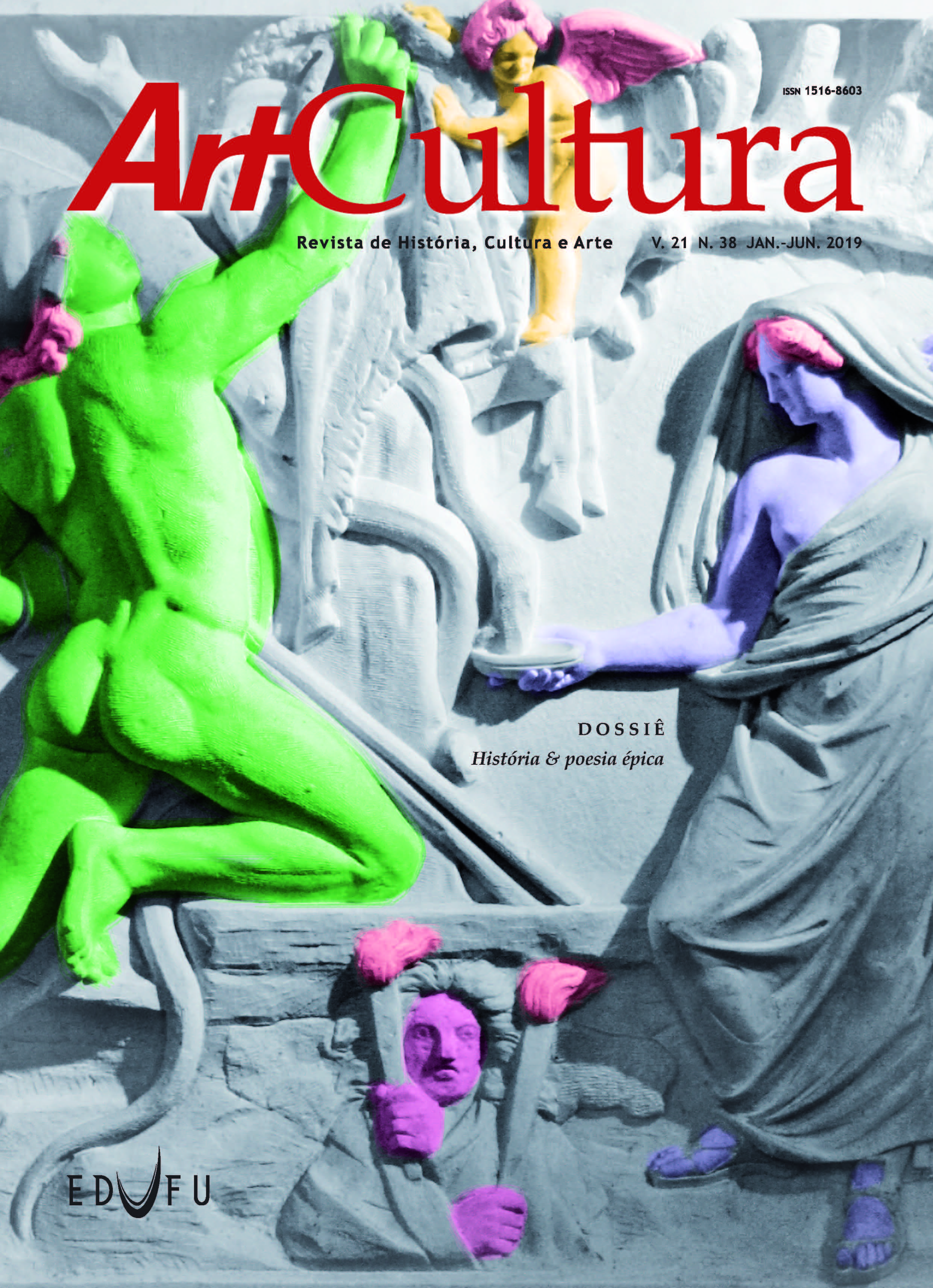the poetical description of the urbs and the convention of the founding heroes in Aeneid book 8: hercules, Evander and aeneas
DOI:
https://doi.org/10.14393/artc-v21-n38-2019-50158Keywords:
Aeneid, temporalities, RomeAbstract
In this paper we analyze an excerpt from Book VIII of the Aeneid in which the Trojan hero visits the site of the future Rome, where he is welcomed by Evander, the Greek, founder of Palanteum, when the arcades celebrated the passage of Hercules through Lazio. From the banks of the Tiber to the Palatine Hill, Evander leads the Trojan guest through spaces that were familiar to the public of the epopee. Based on the hermeneutical historical procedure, we problematize the poet’s choices in compiling a number of foundational narratives that put forward, in turn, an aetiology of the monuments and religious spaces of the urbs: Ara Maxima, Lupercal, Porta Carmentalis, Capitoline Hill. Different from travel narratives, the poetic construction of Rome in book 8 assembles aspects of a variety of temporalities of the same city. In order to understand the topographical references of Aeneid, our study encompasses, in addition to the hermeneutic and exegetical analysis of the Latin text, sources contemporary to Virgil, such as the works of Livy, Dionysius of Halicarnassus, as well as data provided by archeology.
Downloads
References
CASSATELLA, A; VENDITTELLI, L. Roma arcaica: documenti e materiali per una pianta di Roma (fine del VII-inizi del V secolo a.C). Roma: Quasar, 1991.
CLARIDGE, Amanda. Rome: an Oxford archaeological guide. Oxford: University Press, 2010.
COARELLI, Fillipo. Roma. Guida archeologica. Bari: Laterza, 2008.
DIONYSIUS OF HALICARNASSUS. The Roman antiquities. London: William Heinemann, 1960.
FRANCISCO BAUZÁ, Hugo. Virgilio y su tiempo. Madrid: Akal, 2008.
GONÇALVES, Ana Teresa Marques e MOTA, Thiago Eustáquio Araújo. De Iúlo aos Iulii: as gentes romanas e itálicas em busca do passado heroico. PHOÎNIX, v, 22, n. 1, 2016.
GRANDAZZI, Alexandre. As origens de Roma. São Paulo: Ed. Unesp, 2010.
PARATORE, Ettore. História da literatura latina. Lisboa: Fundação Calouste Gulbenkian, 1982.
SERVIUS HONORATUS, MAURUS. Servii Grammatici qui feruntur in Vergilii carmina commentarii. Georgius Thilo and Hermannus Hagen (eds.). Leipzig: Teubner, 1881.
SMALL, Jocelyn Penny. Cacus and Marsyas in Etruco-Roman Legend. Princeton: University Press, 1982.
SUETONIUS. Life of Vergil. In: SUETONIUS. Lives of famous men. London: William Heinemann, 1914.
TORELLI, Mario. Gli acroteri di S. Omobono e l’apoteosi trionfale in Roma Arcaica. In: ABBONDANZA, Letizia; COARELLI, Filippo. Apoteosi da Uomini a Dei: Il Mausoleo di Adriano. Roma, Museo Nazionale di Castel Sant’Angelo. Roma: Munus, 2014.
VERGILIVS. Opera. Vol II. Aeneis. Ed. Remigius Sabbadini. Roma: Typis Regiae Officinae Polygraphicae, 1930.
VIRGILIO. Eneida. Trad. Eugenio de Ochoa. Buenos Aires: Losada, 2004 (edição latim-espanhol).
VIRGÍLIO. Eneida. Trad. José Victorino Barreto Feio e José Maria da Costa e Silva (Livros IX – XII). São Paulo: Martins Fontes, 2004.
VIRGIL. Aeneid, op. cit., VIII. 188. Transl. H. Rushton Fairclough. 1916.
VIRGÍLIO. Eneida. Trad. Odorico Mendes. Campinas: Editora da Unicamp, 2005.
VIRGILIO. Eneide. Trad. Vittorio Sermonti. Milano: Bur Rizzoli, 2007 (edição latim-italiano).
VIRGIL. Aeneid. Transl. Rushton Fairclough. London: William Heineman, 1916 (The Loeb Classical Library) (edição: latim-inglês).
Downloads
Published
How to Cite
Issue
Section
License
Autores que publicam nesta revista concordam com os seguintes termos da licença Creative Commons, adotada a partir da ArtCultura, v. 21, n. 39 (jul.-dez. 2019).
CC BY-NC-ND 4.0: o artigo pode ser copiado e redistribuído em qualquer suporte ou formato. Os créditos devem ser dados ao autor original e mudanças no texto devem ser indicadas. O artigo não pode ser usado para fins comerciais. Caso o artigo seja remixado, transformado ou algo novo for criado a partir dele, ele não pode ser distribuído.
Autores têm autorização para assumir contratos adicionais separadamente, para distribuição não exclusiva da versão do trabalho publicada nesta revista (ex.: publicar em repositório institucional ou como capítulo de livro), com reconhecimento de autoria e publicação inicial nesta revista.


